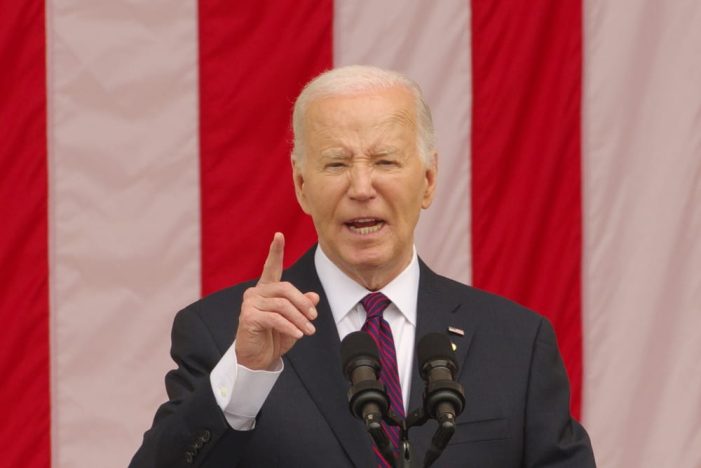Editorial credit: Philip Yabut / Shutterstock.com
By Aaron Reichlin-Melnick | Immigration Impact
On June 4, President Biden issued a sweeping order under section 212(f) of the Immigration and Nationality Act claiming that allows him to “suspend the entry” of most migrants who cross the border between ports of entry, echoing a similar order issued by President Trump in November 2018. Like the Trump action in 2018, Biden’s new order came along with a simultaneous regulation (which went into effect at 12:01 AM on June 5) banning asylum to nearly all people who cross the border between ports of entry while this new suspension remains in effect.
Importantly, U.S. law provides that all people can seek asylum, regardless of how they enter the country. In a speech at the White House, Biden justified punishing people who did not access asylum through means the administration has created at ports of entry, arguing that it was the only way to limit pressure on an overwhelmed asylum system.
One key distinction between Biden’s action and Trump’s 2018 order is that the Biden order contains some crucial exceptions. Unaccompanied children, who were banned from asylum under the Trump order, would remain eligible under Biden’s order. In addition, the proclamation allows CBP officers to exempt some people from the suspension of entry due to “operational considerations” or in urgent humanitarian circumstances.
The ACLU, which successfully blocked the 2018 Trump asylum ban within days, has already announced that it will be filing a lawsuit seeking to overturn this new regulation.
How Does the Presidential Proclamation Work?
Under the terms of President Biden’s proclamation, the entry of migrants is “suspended” as soon as there have been seven days in a row where the U.S. Border Patrol apprehends more than 2,500 people at the southern land and coastal borders. There have only been 13 months between October 2019 and the present with fewer than 2,500 daily apprehensions, so the suspension goes into effect immediately.
This suspension remains in effect until there is another 7-day period where border apprehensions are below 1,500, at which point it will lift 14 days later, meaning that the minimum time it could be in effect is 21 days. After the suspension lifts, if apprehensions again rise above 2,500, it goes back into effect.
Neither the suspension of entry nor the regulation impact asylum seekers coming to the U.S. using the CBP One app at ports of entry along the southwestern border. However, it may limit the ability of the few migrants who are able to “walk up” to a port of entry to begin the asylum process. It could cause them to be turned away and wait months in hopes of winning the CBP One appointment lottery system.
How Does the New Regulation Impact Asylum Eligibility?
Under the interim final regulation put out by the Department of Homeland Security and the Department of Justice, any person who crosses the border without permission between ports of entry, while Biden’s formal “suspension of entry” is deemed ineligible for asylum. They will only be eligible unless they meet one of the exemptions above or if they can show there were “exceptionally compelling” circumstances for their entry.
This is the same standard for individuals seeking to be exempted from the Biden administration’s May 2023 “Circumvention of Lawful Pathways” asylum restriction, which also aimed to restrict asylum for individuals who crossed between ports of entry. Data released as part of a lawsuit seeking to block that rule revealed that in the first two months it was in effect about 11% of people were able to successfully show “exceptionally compelling” circumstances.
Individuals who are deemed ineligible for asylum would have that ban applied at the initial stages of a “credible fear” interview at the border, or later in the process if they manage to make it into the United States, including if they ever apply for asylum with U.S. Citizenship and Immigration Services or in front of an immigration judge in removal proceedings.
Individuals who are deemed ineligible for asylum may still be eligible to apply for “withholding of removal” (a form of humanitarian protection which is harder to win and offers far fewer benefits), or for protection under the Convention Against Torture. Both forms of relief permit individuals to remain in the United States, but do not provide a path to lawful permanent resident status or permit individuals to bring their family members to the United States.
How Does the New Regulation Impact the Asylum Process?
Since the “expedited removal” process was first implemented in 1997, immigration officers have been required to inform people that they have a right to seek asylum and ask them whether they fear persecution before they can be ordered deported. If the person says yes, then they must be referred to a “credible fear interview” with an asylum officer.
Under the new system, this process is eliminated completely and replaced with a process known colloquially as a “shout test.” Now, to receive a credible fear interview, a migrant must affirmatively “manifest” a fear of persecution or expressly inform a Border Patrol agent or other immigration officer that they wish to seek asylum or fear being repatriated.
DHS says that they will post written notices in English and Spanish in detention centers informing people that they can express a fear of persecution to get an interview. They will also play videos in some of the largest detention centers in English, Spanish, Hindi, and Mandarin. But if a person does not speak one of those languages or does not know how to read—or doesn’t receive the message that they are now required to speak up first—they could be ordered deported without ever getting a chance to see an asylum officer.
Crucially, this would eliminate the current requirement that Border Patrol agents document whether every person has a fear of persecution or not, which raises the risk that agents will simply refuse to refer people for fear screenings.
Previous experience with the use of “shout tests” under the Remain in Mexico program and Title 42 have provided extensive examples of Border Patrol agents failing to follow procedure and refer people who express fear.
A 2022 study by the Center for Gender and Refugee Studies involving 97 families expelled across the border at different locations found that not a single person who “manifested” a fear of return to Mexico was provided a fear interview as required by CBP policy at the time. Agents either ignored people or in some cases even told them to “shut up.”
For people who do successfully “manifest” a fear of persecution, the rule also changes the screening standards for the fear interview process. Not only will people be ineligible for asylum under the rule, but asylum officers will now require people seeking withholding of removal or protection under the Convention Against Torture to meet a new “reasonable probability” standard to avoid rapid removal.
In a masterclass of confusion, according to the regulation, this is a “substantially higher” standard than the current “reasonable possibility” standard, but also “somewhat lower” than a “more likely than not” standard.
Taken together, this means that not only will fewer people receive credible fear interviews, but those that do receive them will be subject to a higher standard that’s harder to pass. Because credible fear interviews—and lack of sufficient asylum officers to carry them out—are the biggest bottleneck in the administration’s goal to rapidly process migrants, this change alone could lead to a significant increase in removal orders.
How Will This Impact the Border?
With these rules going into effect immediately, as of June 5, the Biden administration will likely be able to order a higher number of people to be deported without allowing them to access any humanitarian protection. However, despite these changes in process and standards, the core operational limits that have led to hundreds of thousands of migrants being released at the border in the past five years remain unchanged.
There are likely still not enough asylum officers to carry out all the fear screenings necessary, even under the new standards and with the shout tests reducing the number of people who get fear screenings. That alone will likely lead to many people still being released.
There are also still major diplomatic issues which prevent the United States from removing people to countries like China, India, Venezuela, or Mauritania. And there are still major resource challenges that prevent the U.S. government from deporting tens of thousands of people by plane each month. For example, in May 2024, ICE flew 151 removal flights in total, an average of 4.9 per day—the third highest total since January 2020—nearly all of which were to destinations in the Western Hemisphere.
As a result, it’s highly likely that some populations of migrants—especially those from outside the Western Hemisphere—will continue to be released at the border and placed into removal proceedings inside the United States, where they will have to fight this asylum restriction potentially years in the future. Meanwhile, the population most impacted will likely be people who can be deported to Mexico (which includes Mexicans and people from Cuba, Haiti, Nicaragua, and Venezuela), and Guatemalans, Hondurans, and Salvadorans who can be far more easily deported via a short plane ride than people from further abroad.
In short, the new executive order is highly unlikely to “shut the border” to asylum seekers. Instead, it will likely bring more confusion about the process and increase the arbitrariness with which the U.S. government responds to people seeking safety in this country. And while border encounters may drop in the weeks after this rule goes into effect, as migrants take a “wait and see” approach, any drop in crossings is likely to prove temporary.
Only sustained investment in our humanitarian protection system by Congress and a new vision of a modern, functional, and robust asylum will be able to address the issues caused by the greatest levels of displacement in modern history.
At present, the government is offering neither investment nor solutions. It is essentially crossing its fingers that the asylum system will fix itself by simply turning more people away.

